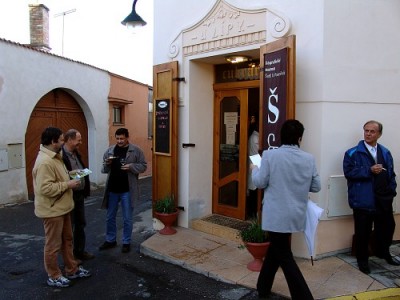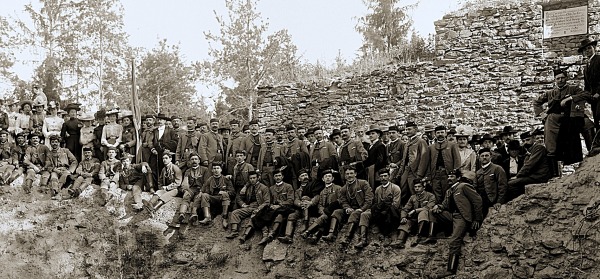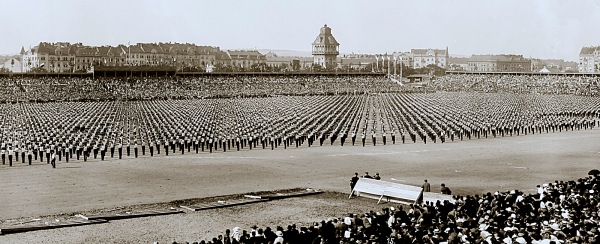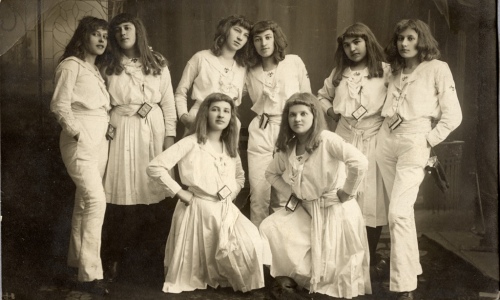Historical photographs—100 years of Tábor Gym Hall
Third exhibition of Šechtl & Voseček Museum of Photography.
- Texts:
- Photographs (just part of original exhibit):
You are the source of our strength.
You will fly to reach your goal,
In spite of all temests around you.
From the opening day:

The history of Sokol

Sokol was founded by Miroslav Tyrš and Jindřich Fügner in 1862 as the first physical education organization in the Austro - Hungarian empire at a time of political freedom in the 1860's. Many significant Czech patriots took part in the foundation of The Prague Gymnastic Association (renamed Prague Sokol). The foundation of the unit in Prague took place on February 16th, 1862. Eight other units were founded in Bohemia and Moravia in the same year. The leader M. Tyrš invented gymnastic exercises and terminology (The Basis of Gymnastics). In 1869, the Gymnastic Society of Czech Women and Girls was founded, and Klemena Hanušová, a proponent of female physical education and Tyrš ?s pupil, became the leader of the society.
Sokol flourished between the two World Wars. During this time, membership grew to over a million. Important statesmen including the first two presidents of the Czechoslovak republic, T. Masaryk and E. Beneš, were members of Sokol. Sokol gymnasiums were built in even small communities. Sokol members successfully represented their country at the Olympics and world championships (Supcik, Vacha, Hudec, Gajdos, Dekanova and others). The program of Sokol has always been versatile, attractive for people of all ages. Besides regular training of all age groups, units organized sporting competitions, cultural events including drama, literature and music, excursions and youth camps. Sokol educators espoused the ideals of the movement to its members and were active in organizing discussions and exhibitions. The CSO published a wide range of magazines and booklets to assist the work of its units, including advice on organizing events and music for cultural performances and festivals. The peak of the Sokol activities were Sokol festivals.
Sokol was almost liquidated three times. It was banned by all totalitarian regimes in Czechoslovak history. Firstly, Sokol was banned during the World War I., in 1915. Secondly, it happened during the Nazi occupation of Czech lands and finally, Sokol was banned by the communists after 1948. In 1968, struggles for Sokol revival were killed by normalization and so after 42 years of hibernation, Sokol was restored for the fourth time in 1990.
— Excerpts from www.sokol-cos.cz
Sokol Festivals "SLETS"

Even though the beginnings of the tradition of Sokol festivals were in the last Century, the tradition survived until today. The Sokol festivals are unique phenomenon and they were always considered by all the citizens to be a very special event.
I. festival 1882 took place on June 18th, on the Strelecký Island in Prague. 700 men exercised under the leadership of Miroslav Tyrs. 1572 Sokols formed the procession.
II festival 1891 took place in "Kralovska obora". More than 2 400 participants showed their exercises in front of 7 000 people. A procession containing 5 000 members including friendly foreigners marched through Prague.
III. festival 1895 took place on the Letna plain. 5 000 participants took part in competitions and the procession. More than 30 000 people came to watch the show already.
IV. festival 1901 included excercise of 876 women with clubs. People from Vienna, France, Poland and Slovenia competed here, too. The procession of 11 000 sokols climaxed by the homage to the city of Prague.
V. festival 1907 was first "great" festival, lasted four weeks. The festival scene "Chess match", picturing the victory of the Hussites. More than 12 000 sokols in the procession.
VI. festival 1912 lasted five weeks. More than 30 000 Sokols participated and 300 000 came to see it. Sokols from the USA, France and Slavic countries performed as well. The scene "Marathon" had 1 500 participants.
VII. festival 1920 visited more than 500 000 people including president Masarzk. More than 100 000 members participated. The foundation of the Czechoslovak Republic was celebrated by the scene "Construction of the Statue of Liberty". 78 000 Sokol members walked through Prague.
VIII. festival 1926 took place on Strahov. 140 000 participants arrived and about 800 000 people came to watch them. T. G. Masaryk gave a flag to Sokols. Prominent Czechoslovak artists performed in the scene.
IX. festival 1932 became a celebration of the 100th anniversary of the birth of M. Tyrs. The festival scene was called "Tyrs' s Dream". The festival included a run from nine parts of the country, winter festival games, high school games, general competition of the Slavonic Sokols, many cultural programs, sporting and cultural competitions. 190 000 members participated and one million people watched.
X. festival 1938 took place during the time of the fascist threats. 30 000 men at the same time performed the famous exercises "Oath to the Republic", the same number of women did for the first time the "great choreography". About 350 000 Sokols exercised, more than two million people came to watch them.
XI. festival 1948, being prepared right after the war, finally took place after the communist putsch in February. The scene "Faithful Forever" commemorated the Sokols that died during the war.The number of participants of the festival exceeded 500 000. During the processions, demonstrations against the communist regime and president Gottwald took place. Communists socially punished more than 1 000 Sokol members after the festival.
XII. festival 1994 took place after a break of 46 years. 23 000 people performed on Strahov, out of which 1 800 were from abroad.
— Excerpts from www.sokol-cos.cz
Studio Šechtl & Voseček
Three generations of the Šechtl family have been photographically recording life in Tábor for the past 140 years. Over seventeen thousand glass plate negatives have been preserved, from the years 1864 to 1940. These plates document the changes in Tábor as well as many interesting people including Emperor Franz Josef, presidents T. G. Masaryk and E. Beneš, sculptor František Bílek, inventor František Křižík and musicians Oskar Nedbal, Josef Suk and Bohuslav Foerster.
The founder of the firm, Ignác Josef Schächtl (1840–1911), who later changed his name to Šechtl, was photographically active from 1865 in Kladno, Plzeň and Nepomuk, before finally settling in Tábor in 1876. His first studio was at 333 Mikolas Husi Square. From 1878–1886 he worked with another photographer, Alex Seik. The day his son was born in 1877, Schächtl met Jan Voseček, a travelling salesman, who became a partner in the firm, and practically a member of the family. Ignác Schächtl was very interested in technological innovation, and was the first person in Southern Bohemia to show moving pictures. He experimented with with many photographic techniques. He was one of the pioneers of capturing movement in still photographs.
Josef Jindřich Šechtl (1877–1954) continued his father's tradition. He commenced the building of a modern photographic studio, in the main street, where the Hotel Palcát now stands. Josef Šechtl specialised in art photography, and was famous for his quality portraits. He provides us with a unique photo documentary of his time. Thanks to his attention to detail, his reputation grew, and the family business blossomed.
Josef Šechtl (1925–1992) and his wife Marie Šechtlová (1928–2008) took over the studio. Marie in particular, brought a feminine emotive element to their work. In the 1960's, she was among the most successful photographers of "the poetry of the everyday". Following the nationalisation of the studio by the Communist government in 1953, they continued as freelance photographers, mounting many exhibitions and producing a number of publications. Together they were a team of art photographers, pioneering colour photography and the use of large photographs for interier decoration.
... the origin and meaning of Šibřinky?

In the early part of 1865, after an extended discussion and various proposals, it was decided by Sokol Prague to hold a Sokol costume ball. Fügner proclaimed: “It has to be a real Sokol costume ball”. Then he turned to Tyrš: “You should find some appropriate name for it”. Tyrš searched Jungmann dictionary; he discarded first few ideas. Then he discovered the verb Šibřiti. In the past it originated from imitation of sparrows' song, and later it stood for practical joking and clowning. From there it was just a short step for designating the Sokol costume ball Šibřinky.
Fügner himself took charge, with enthusiastic help of Gabriel Žižka, who had organized various balls in the past. Fuegner sent out invitations, which caused excitement by their unusual form: icon lůp o cenok YKNIŘBIŠ 5681 aronú 52 end alokos ohéksžarp ěnčivcolět v ěnidoh 7 o ketáčaz (in English: thgindim ta gnidne YKNIŘBIŠ 5681 yraurbef 52 lokos eugarp fo llah eht ni kcolc'o 7 ta gnitrats). Some were angry and others were laughing that they did not immediately recognized that they must read the invitation from right to left. Some even suggested that it was in Turkish or Hungarian.
In the evening of 25th February 1865 the entire Sokol hall neighborhood was full of spectators. In front of the Sokol hall were guards with torches. As the carriages carrying the masked guests pulled up to the entrance, they were greeted by an imposing bear.
The inside was fully decorated and the entire main hall became a mass of whirling masked dancers. Fuegner was strolling through in a velvet costume of a mafioso. Tyrš transformed himself into a Spanish hidalgo.
The event was a great success, and the tradition of šibřinky is being continued to this day. It was also enthusiastically continued by the American Sokol Units, many of which still hold this dance annually, even though the origin and meaning of the name is not known to most of its members.
— Information on the above was extracted by Bo Bata from the biography “Miroslav Tyrš prohry a vítězství” by Zora Dvořáková